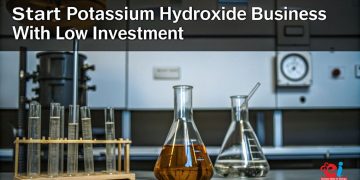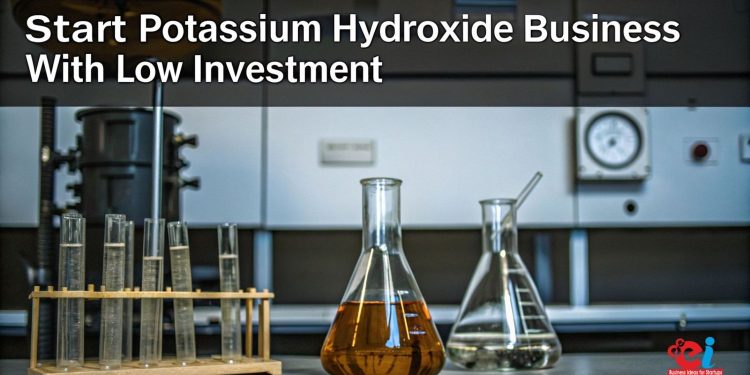Across the globe, the chemical manufacturing industry is ever-changing. KOH or Potassium Hydroxide is a versatile industrial chemical that has growing applications in agriculture, food processing, cosmetics, and even in the pharmaceutical industry, and battery production. Traditionally, large corporations produced KOH through the capital-intensive method of electrolyzing potassium chloride. This approach, however, creates financial and infrastructural challenges for small and medium enterprises (SMEs). Unfortunately, there’s an easier method: producing potassium hydroxide through potassium carbonate. This is more accessible to many.
This method of production is not only adaptable, but also economically beneficial. This makes it perfect for SMEs eager to get their feet wet in the chemical industry without spending a lot of money. Coupled with the country’s India’s tilt toward self-reliance in chemical manufacturing as well as encouraging policies aimed at the MSME sector, investing in this approach is logically sound and commercially attractive.
Potassium Hydroxide in Industry
Feasibly, hydroxide of potassium is best known as caustic potash and is a highly sought after compound in the consumer and industrial world. It’s utilized in soap, biodiesel, food additive, detergent and even fertilizer production. Due to its alkaline features, potassium hydroxide plays an important role in numerous saponification, extraction, neutralization, and many other operations as a reactant.
As a source of potassium in fertilizers, KOH is required throughout the world because of its use in agriculture, energy storage for alkaline batteries, and personal care items. Sectors such as electronics and pharmaceuticals have particularly increased their reliance on high-grade KOH. For SMEs, the capability to produce KOH locally and economically stands as an opportunity to cater to local industries that are otherwise dependent on large-scale or foreign suppliers.
What Makes Potassium Carbonate A More Favored Alternative
The conventional approach for potassium hydroxide production encompasses the electrolysis of potassium chloride (KCl) which is rather sophisticated and expensive. The process consumes electricity at a high rate, requires a significant corrosion-resistant infrastructure, and needs skilled supervision. Most small and medium enterprises lack the necessary finances to construct an electrolytic KOH production facility economically.
An easier and more cost-effective option involves potassium carbonate as a primary ingredient. Using slaked lime instead of electrolysis machinery simplifies the entire process. Metathesis reaction, also referred to as double displacement, occurs when potassium carbonate and calcium hydroxide react in solution to produce potassium hydroxide and solid calcium carbonate.
Reaction:
K₂CO₃ (aq) + Ca(OH)₂ (aq) → 2KOH (aq) + CaCO₃ (precipitate)
The process utilizes relatively low temperatures and readily accessible reagents. Because of low energy requirements, it is more appropriate for rural or semi-urban industrial regions. This is particularly useful for developing economies where energy expenses are high and the industrial sector is based on small scale industries.
Related: Top 20 Chemical Imports to India in 2025
Production Process: A Simple, Safe Reaction
The first step of the process consists of dissolving potassium carbonate in water to obtain a clear solution. Calcium hydroxide is also dissolved in water, and is added to the potassium carbonate solution in a controlled manner. With constant stirring at a temperature of 60-80 °C, the reaction is completed with the production of potassium hydroxide in the solution and calcium carbonate in solid form. The calcium carbonate precipitate is filtered out, and the remaining KOH solution can either be evaporated to concentrate it further, or dried to obtain KOH flakes or powder, depending on the intended use.
This approach enables the possibility for manual or partially automated procedures, remaining within the resources of an SME. Thus, quality control and batch production are simpler and more convenient. Since the primary byproduct, calcium carbonate, is non-poisonous and commonly employed in the construction and paper industries, waste management is simple.
Infrastructure and Machinery: Minimal Setup, Maximum Utility
The basic and fundamental infrastructure needed for a production unit includes the following: a reaction tank equipped with temperature control, mixing or stirring unit, and a filtration system. Other support facilities include storage tanks for raw materials, evaporation pans or vacuum dryers, and a packaging line for finished products.
Within the range of 1,500 to 2000 sq ft, a small scale unit can comfortably operate. Such a unit can be set up in industrial zones, chemical hubs, or semi-urban areas where logistics and access to raw materials are available. Due to the absence of large electricity-consuming components, operational costs are low. The enhanced efficiency and sustainability of the unit allows it to operate with a few trained workers provided that safety measures are in place.
Uses and Target Industry Segments
KOH produced using this route can be supplied to multiple industries. Soap and detergent industries buy caustic potash constantly. Some fertilizer companies also make use of potassium hydroxide as a pH adjuster and a source of nutrients. KOH is used to treat fabrics in textile dyeing and finishing units, while food grade KOH is used as a stabilizer or thickening agent in food processing industries.
Pharmaceuticals and cosmetics industries require high purity KOH for preparation of the formulations. These SMEs can capture these markets by providing quality, affordable rates, and swift responses. Packaged KOH under private label can also be sold to agrochemical merchant, hardware merchants, or intermediaries for online shops, thus expanding the revenue source.
Environmental and Legal Aspects
Due to its strongly alkaline properties, potassium hydroxide is categorized as a hazardous chemical. Its production is bound to the overgrowing standards of safety regulations. The encouraging point is that the method with potassium carbonate is inherently safer than traditional electrolysis methods because it has low emissions and manageable waste.
Regardless, entrepreneurs should consider observing the local and national laws and policies. Certification from the pollution control board, licenses for handling chemicals, and fire safety precautions as well as appropriate marking standards are a must. Training for employees on the use of corrosive materials is mandatory, and basic means of emergency response must be installed within the facility.
Working with professionals such as Niir Project Consultancy Services (NPCS) enables business to expedite the approval procedure, design a compliant facility, and preserve adequate documentation to circumvent legal or operational impediments.
Related: How to Set Up a Manufacturing Business of Potassium Chlorate?
How NPCS Can Help You Launch Successfully
While the production method is technically straightforward, launching a business requires strategic planning, market understanding, and operational preparedness. This is where Niir Project Consultancy Services (NPCS) offers tremendous value. With years of experience in the chemical and process industry, NPCS provides custom-tailored solutions to help SMEs hit the ground running.
From preparing Detailed Project Reports (DPRs) and investment feasibility studies to selecting suppliers and designing plant layouts, NPCS ensures that every detail is aligned with the entrepreneur’s goals. Their team also offers financial forecasting, regulatory compliance assistance, raw material sourcing, and support with funding proposals under MSME schemes.
For entrepreneurs looking to take advantage of the growing demand for potassium-based chemicals, NPCS can be the ideal partner to navigate the journey from idea to implementation.
Conclusion: A Smart Entry Point into the Chemical Industry
The method of producing potassium hydroxide from potassium carbonate offers SMEs a rare combination of simplicity, safety, scalability, and profitability. It breaks down the traditional barriers to entry in the chemical manufacturing industry by eliminating the need for expensive electrolysis equipment, high energy costs, or complex infrastructure. At the same time, it offers access to a stable and growing market with numerous industrial applications.
For SMEs and aspiring entrepreneurs, this process represents a clear path to build a business that is not only financially viable but also sustainable and scalable. With the right support system, especially from expert consultants like Niir Project Consultancy Services, launching a KOH production unit becomes a highly achievable and strategic endeavor.


























